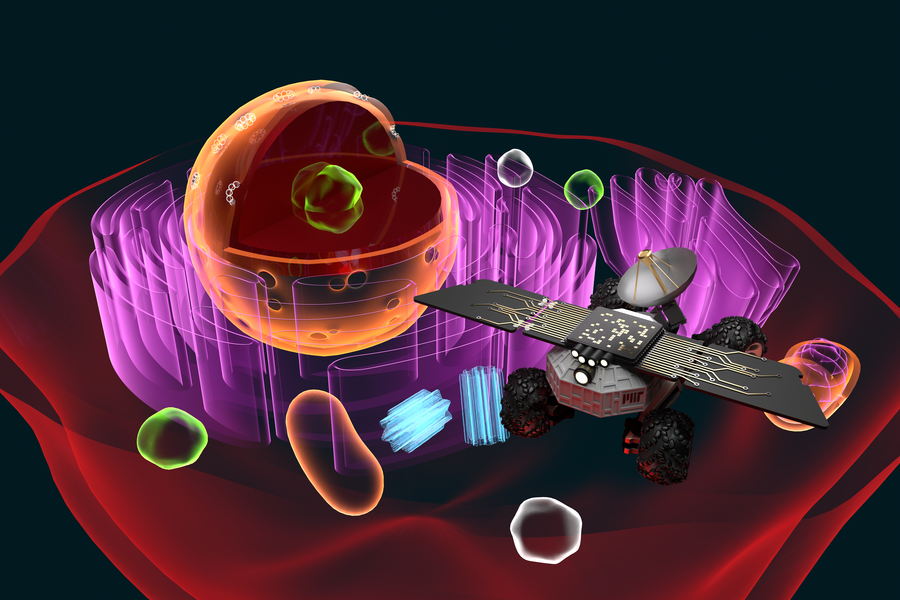Intracellular antennae open up a wide range of possibilities in medical diagnosis, treatment, and other areas as a result of their superb ability to monitor and potentially direct cellular activity in real-time.

Image Credit: MIT
Now, a team of researchers from the Media Lab at MIT has developed a sub-mm intracellular antenna that demonstrates compatibility with 3D biological systems and can function wirelessly inside a living cell.
Published in the journal Nature Communications, the team introduced their “Cell Rover” technology which opens up new opportunities for fundamental and applied biology.
The Cell Rover, so-called to invoke the explorations of new frontiers, operates at low MHz frequencies, which makes it ideal for exploring living systems.
You can think of the Cell Rover as being on an expedition, exploring the inner world of the cell.
Deblina Sarkar, Assistant Professor, AT&T Career Development Chair at the MIT Media Lab and Head of the Nano-Cybernetic Biotrek Lab
Acoustically Actuated Antenna
The Cell Rover developed by the team at MIT is significantly smaller than a typical cell. The team worked with oocyte cells throughout the study, and the Cell Rover was 0.5% below the average cell volume, which means that when it is in use, it will not cause damage to the cell itself.
However, one of the main challenges that the scientists faced was ensuring the proper functionality of the Rover. This is because traditional antennas must be comparable in size to the wavelength of the electromagnetic waves that are being transmitted and received.
Resultingly, this produces extremely large wavelengths. Thus, increasing the frequency to reduce the ratio and, subsequently, the antenna size is counterintuitive because high frequencies generate heat which can damage living tissue.
When an AC magnetic field is used for excitation, electromagnetic waves are converted into acoustic waves, which can be detected wirelessly by near-field inductive coupling via a coil.
For specific frequencies, the acoustic wavelength in the magnetostrictive material is about five orders of magnitude less than the EM wavelength, and, in comparison to traditional EM antennas, magnetostrictive antennas can have smaller orders of magnitude. This limits cell damage and allows the Cell Rover to monitor cellular activity in real time.
Cellular Cyborgs
Living cells are machines and form the basis of all biological systems. Therefore, being able to probe and manipulate at the cellular level can offer key insights into biology and disease as well as lead to sophisticated health monitoring methods and advanced treatment options.
The MIT team report that intracellular antennae can be used for exploring the fundamentals of biology through the monitoring of natural processes within cells.
The most exciting aspect of this research is we are able to create cyborgs at a cellular scale.
Deblina Sarkar, Assistant Professor, AT&T Career Development Chair at the MIT Media Lab and Head of the Nano-Cybernetic Biotrek Lab
“We are able to fuse the versatility of information technology at the level of cells, the building blocks of biology,” says Sarkar.
This means that the Cell Rovers could potentially offer valuable insights regarding cancer and neurodegenerative disease research.
The technology could be used to detect and monitor biochemical and electrical changes associated with the disease over its progression in individual cells.
Deblina Sarkar, Assistant Professor, AT&T Career Development Chair at the MIT Media Lab and Head of the Nano-Cybernetic Biotrek Lab
Furthermore, the Cell Rover could be put to use in the field of drug discovery, as the technology could track and monitor the reactions of live cells to various drugs in real time.
“This opens up unprecedented opportunities for extremely precise diagnostics, therapeutics, and drug discovery, as well as creating a new direction at intersection between biology and electronic devices,” says Anantha P. Chandrakasan, dean of the MIT School of Engineering and the Vannevar Bush Professor of Electrical Engineering and Computer Science.
The team was also able to show that multiple Cell Rovers can be used to simultaneously communicate among themselves whilst providing information via the acoustically actuated antenna. With further research and development, the team believes that the Cell Rover could perform a wide range of tasks that range from intracellular computing and information processing for autonomous exploration to cell modulation.
References and Further Reading
Joy, B., Cai, Y., Bono, D. and Sarkar, D., (2022) Cell Rover—a miniaturized magnetostrictive antenna for wireless operation inside living cells. Nature Communications, [online] 13(1). Available at: https://www.nature.com/articles/s41467-022-32862-4
Jarvis, M., (2022) Cell Rover: Exploring and augmenting the inner world of the cell. [online] MIT News | Massachusetts Institute of Technology. Available at: https://news.mit.edu/2022/cell-rover-exploring-augmenting-inner-world-cell-0922
Disclaimer: The views expressed here are those of the author expressed in their private capacity and do not necessarily represent the views of AZoM.com Limited T/A AZoNetwork the owner and operator of this website. This disclaimer forms part of the Terms and conditions of use of this website.